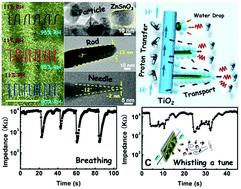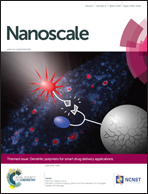Rational tailoring of ZnSnO3/TiO2 heterojunctions with bioinspired surface wettability for high-performance humidity nanosensors†
Abstract
We developed a novel kind of branched heterostructure by hydrothermal growth of ZnSnO3 nanostructures on TiO2 electrospun nanofibers, and demonstrated its enhanced ability to sense humidity through a sequential cactus-inspired tailoring of the ZnSnO3 nanostructures. Combining these results with first-principles calculations, it is deduced that the concentration of water molecules adsorbed on the ZnSnO3/TiO2 heterojunction surface can be increased by reducing the surface potential barrier. Meanwhile, the bioinspired ZnSnO3 nanoneedles, which form branches on the heterostructures, can further boost their adsorption abilities for water molecules via a water collection process. The adsorbed water molecules on the tips of the ZnSnO3 nanoneedles desorb easily in a low-humidity environment due to the small area of the tips (1.5–2.5 nm). Thus, the optimal ZnSnO3/TiO2 heterostructure exhibits response and recovery times of ∼2.5 s and ∼3 s, respectively. Its good sensitivity may enable it to detect tiny fluctuations in moisture and relative humidity that may surround any high-precision instrument.


 Please wait while we load your content...
Please wait while we load your content...